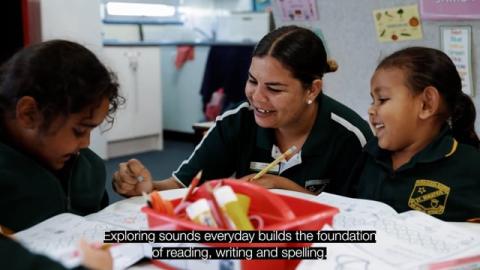Phonics is the relationship between the 26 letters of the English alphabet, and the approximately 44 speech sounds they represent.
Phonics is essential for children to become successful readers and writers in the early years of schooling and beyond.

Download the Phonics printable resource
Curriculum
Early Years Learning Framework (ELYF)
- Children are connected with and contribute to their world
- Children are confident and involved learners
- Children are effective communicators
- Uses single-letter grapheme-phoneme correspondence and common digraphs to decode and encode words when reading and creating texts. (ENE-PHOKW-01)
Families
Read (2 mins)

Phonic knowledge and word recognition are among the range of resources students use as they read increasingly complex texts. There are 26 letters of the English alphabet, however each letter may have various sounds.
The development of phonics is the ability to relate the name of a letter with the sound of a letter. For example, the letter name ‘c’ (cee) but can make the sounds ‘s’ and ‘k’.
“If a child memorises ten words, the child can read only ten words. But if the child learns the sounds of ten letters, they will be able to read: 350 three sound words, 4,320 four sound words, 21,650 five sound words” Kozloff 2002
Explore (10 mins)

Some ideas for learning in the everyday:
- Read to and with your child.
- Read a variety of books – different genres and different levels of difficulty.
- Read with your child and point out the different sounds in the words.
Books to support literacy:
- Scaly-tailed Possum and Echidna by Cathy Goonack
- The Lizard Gang by Kirra Somerville
- Big Rain Coming by Katrina Germein
- Little Bird’s Day by Sally Morgan
Teachers
Reflect (30 mins)

Reflect on your knowledge and practice. Consider the EYLF, NSW Syllabus and LPs:
- Where have these children come from?
- Where are you taking them?
Think about the learning that happens in your classroom that builds the knowledge and skills for phonics.
What do you expect from the early learner?
What do you want parents to know about phonics?
How is phonics used across the curriculum?
Consider this skill – What are the connections between literacy and numeracy?
This is an opportunity to share what phonics looks like in your classroom.
Engage (45 mins)

Engage in a learning conversation with parents. Suggested conversation starters:
- Is there anything in the video that challenged your thinking about learning?
- What foundational phonics skills did you see in the video?
- How are the children:
- Practising their skills?
- Testing their ideas?
- Building their knowledge?
- What opportunity can you create or do you have at home that develops phonics?